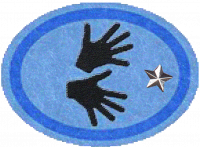Respuestas para la especialidad JA de Auslan (Lenguaje de señas australiano) - Avanzado
Nivel de destreza
2
Año
2023
Version
19.12.2025
Autoridad de aprobación
Unión Australiana
It is helpful before you start to recognise the difference between Auslan and ASL (American Sign Language). A common misconception is that all English-speaking Sign Languages are the same. Even the alphabet is different! Auslan is more closely related to BSL (British Sign Language) and NZSL (New Zealand Sign Language).
1
Para consejos e instrucciones, véase Auslan (Lenguaje de señas australiano).
2
It is highly recommended that you find a Deaf person to teach this. If you know someone who knows Auslan, ask them for a recommendation. Otherwise search online for your closest Deaf organisation to contact. If you have very generous trainers, they might even stay to run a game with the whole club! You will be amazed at what they can do with a group of pathfinders who have never learnt a single sign!
All instruction time should be considered a voice-off experience. Ask students to use gestures, pointing and writing to get them to rely on their signing and fingerspelling. Not only does this increase the speed of their learning, but gives them an idea of the communication barrier that Deaf people experience on a daily basis!
3
Towards the end of training, ask students to pair up and have a conversation based on some basic key words they have learnt. Give them some topics to get them started and teach them to rely on fingerspelling for unknown words!
4
E.g., common objects, questions, common phrases and actions, colours, greetings, emotions, the alphabet, numbers, days of the week, and signs related to the songs (below).
It is strongly suggested to learn some church/faith specific words. Ask a Deaf church nearby or Youtube video by Darren Kirkegard.
You can use the online dictionary for help or reminders (Auslan.org), but keep in mind Auslan is an ever-changing language and if relying on sources such as this instead of practising Auslan grammar, you can turn into more of a signed-English style, which is not Auslan.
5
Some examples:
a. Jesus loves me
b. Jesus Alphabet Song
c. God is so Good
d. This Little Light of Mine
e. I’ve Got the Joy in my Heart
f. Rejoice in the Lord, Always
g. Fruit of the Spirit
6
You will definitely need a Deaf assessor for this requirement! This uses a wide range of visual language skills and a Deaf person can give very helpful feedback on how to improve the story!
Storytelling is a key skill of communicating in Auslan. While English speakers tend to adopt a past-tense, third person point of view and convey information from an indirect “observer” perspective, Auslan signers tend to enact speech and dialogue as if they are directly involved. This leads to Auslan being an incredibly visual language which prefers to “show” rather than “tell”.
When telling a story using Auslan, it is very important to use a lot of facial expression, as well as body language, entity and depicting signs. To tell a good story, you must include descriptive characters and settings so that the viewer can understand who and where the story is being told. The positions that the storyteller adopts can show who is talking, e.g. ‘looking upwards’ if you are a child, and ‘looking downwards’ if you are talking to a child. In Auslan, it is important that the signer uses the body, through gestures, signs and enactment, to both show and tell meaning.
Auslan employs a 3D space, thus rendering it a non-linear language. With avenues such as depicting signs, nonmanual features and enactment to convey meaning, there is less dependence on lexicalized signs. Auslan becomes more linear through the sequential employment of single signs to have single word meanings, however overdependence on lexicalized sign can be awkward and labourious with minimum expression and context. By exploiting 3D space , signers can exploit the pragmatics face-to-face of Auslan, enabling signers to flavour their signing with intonation, expressivity and different shades of meaning.
For a great example, watch video “Fish vs Shark” by Edan Chapman. Even someone who doesn’t know Auslan would understand this whole story because of his impressive use of visual and expressive Auslan features.
6a
6b
6c
7
Experiencing Auslan and engaging with the community not only is a great way to expose the learner to an immersive language experience, but is also is a helpful way to build connections with the everyday users of Auslan – the Deaf! You will get to see how fast they sign to each other, but probably will be surprised on how much you pick up.
Organised events that include an interpreter allow the learner to witness the live translation of the language and can learn to recognise new signs.
It will also allow an opportunity to practise new Auslan skills with the Deaf community. Make sure to sign, “SORRY, AGAIN PLEASE” or “FINGERSPELL PLEASE” if you miss anything!



